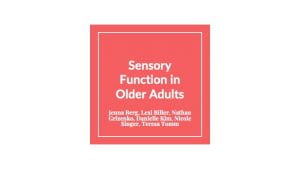










Posts
Sensory Function in Older Adults



































Universal Design Newspaper Assignment

Cognition Artifact
The first thing that came to mind for me when I thought of functional cognition was a Bop It. Now if you have played this, you will know that a lot goes into it! The toy will prompt you with an action (bop it, pull it, twist it, spin it, or flick it) and you have to do that action within just a few seconds, or you’ll lose. The object of the game is to do as many correct actions as possible in succession.
This incorporates many aspects of cognition. An individual needs to have the information processing, conscious awareness, and comprehension to register and process the initial instruction. They will then need to utilize their working memory and be able to integrate this in order to carry out the appropriate response. A few other aspects of cognition the Bop It requires are emotional regulation, initiation, and motivation.
Mental Health Artifact
To me, this poem embodies mental health. In “despite it all,” the poem acknowledges individual struggle and any burdens someone may have. While at the same time, in “and here you are living,” the poem highlights the life in that same individual. To me, it speaks into their strength and power to overcome. Furthermore, this poem, coupled with the simple drawing, communicates self-love, acceptance, and harmony, which I feel are all crucial in mental health. This poem, only a few words long, definitely could be interpreted differently, but to me, I see this as a poem about heaviness, but also perseverance and joy.
Pediatrics Parent Handout
This is a mock handout I could give a parent to communicate the importance of an identified skill to child’s functional performance. This handout is designed for a specific client working on a specific skill, but it could be adapted to fit different clients. Below the handout is a description of the case this handout was based on.
Mock case:
Edric is an 18-month old boy diagnosed with ASD. He lives at home with his father, mother, and older brother. He attends half-day daycare and will be beginning outpatient occupational and speech therapy services. Edric’s parents report that he enjoys spinning objects for long periods of time. He will often become tearful or agitated with disruptions to his daily routine or new environments. Edric shows strengths in visual processing, loves music, and enjoys watching cartoons and taking baths. Edric prefers to play alone, which often results in his older brother William (3 years old) becoming frustrated when he does not want to play together. Edric does not use words to communicate; however, he will often use his parents’ hands as tools to indicate his needs.
OT Artifact
OT Artifact
In this video I explain what occupational therapy is to me. I use the comparison of the practice to an ‘artifact,’ my car.
Beginning my first year of graduate school, I felt overwhelmed. I dug into what exactly I have been feeling and have finally put those feelings into words. Last week, I realized it is, in part, a combination of the material I will need to learn and the responsibility I will have for people’s lives. It was then that I aligned this with how I felt when I first learned how to drive. I continued to reflect and found many similarities between how I use and take care of my car and how I use and take care of my body. This metaphor helped me process and articulate how I feel through relating my car, something I use so frequently, to my future profession.
Transcript:
Welcome to my car. This car takes me where I need to go. It allows me to work, it allows me to get groceries, it allows me to travel across the country on road trips. It has allowed me to visit my friends and family. It has taken me the places I want to go and the places I need to go.
I need to make sure I have enough gas in the tank to get where I am going. I keep up with routine maintenance to ensure it is functioning to its greatest potential. When it breaks down, I take it to the shop. The mechanic figures out what’s wrong and fixes the problem. It could be a quick fix, I could need to wait for a new part, or it could be a chronic condition that requires regular work. If I can’t afford the necessary repair, I may need to adjust the way I use my car. Ultimately, I need to do maintenance and have repairs done, because without them, my car would not be functional in the way that I need it. And I would not be able to do the things I do and enjoy and live my life the way I live it.
Our bodies, metaphorically, are not that unlike a car. They allow us to do the occupations we do, such as working, going to get groceries, or traveling the country. We, like cars, require regular maintenance. Our bodies need, to name a few, proper nutrition, exercise, rest, shelter, healthy human interaction, and ultimately, meaningful occupation.
We also break down and have accidents. And when this happens, we too need to seek professional help. Occupational therapists play a crucial role in client-centered care that enables growth and healing in all aspects of life. It is through occupational therapy and holistic healing that we are able to adapt, rehabilitate, and restore meaning to our lives.
As a first-year student, I have felt overwhelmed. Continuing with car metaphors, I feel like being a student in occupational therapy is much like learning to drive. Both involve a lot of knowledge and guidelines to practice, and for both, human lives are in our hands. Both are exciting and rewarding, but both have a great responsibility as well. I, like a 15-year-old getting their temps, am excited to learn all I can and grow and develop until, in 3 years, I receive those keys, start that engine, and drive into my future as an occupational therapist.
Adult Mental Health – Setting Reflection
I was so excited to read about OT in mental health! I was never able to observe in the mental health setting specifically, so I have really been looking forward to this week’s material. I was surprised by the involvement OTs have in the community setting. I thought mental health OT would be more in inpatient settings.
First off, I was not aware OTs treated patients with dementia specifically; I thought dementia was addressed more so as a comorbidity. I aspire to work with older adults. As dementia is typically a disease associated with old age, I will undoubtedly encounter many individuals with this disease. Furthermore, I didn’t realize how crucial OT can be in making home modifications, adapting tasks and environments, teaching caregivers, and developing new routines to help these individuals maximize function and independence.
Lastly, I did not realize the degree OTs work with individuals with substance abuse. I also didn’t realize how little I know about substance abuse in general. I found it interesting that OTs are able to help these individuals with instrumental acts of daily living. In retrospect, this makes a lot of sense. It was just not something I had seen or heard of until now!
Certified Hand Therapy – Setting Reflection
I absolutely loved Dr. Sharon Flinn’s interview. She has such a cool story and journey! I appreciated when she was speaking about her initial years as a Certified Hand Therapist (CHT); she realized that her methods of splinting and exercises did not work for every patient, so she sought to find what would work. She explained that this lead her to industrial rehabilitation, where she started her own clinic (again, so cool).
In the industrial rehab clinic, Dr. Flinn realized that occupation was what was missing from her previous work in outpatient. I have found this to be a common theme in several of these interviews: moments of realization of the importance of occupation. It’s this that continues to grow my appreciation for the use occupation in our profession.
It wasn’t one of Dr. Flinn’s “characteristics for an OT,” but after listening to her interview, and reflecting on what I thought made her a great CHT and OT, I dubbed it to her courage. There were so many times Dr. Sharon Flinn was “the first” or “the only” in her career. She left jobs where she felt she wasn’t growing, able to be adequately mentored, or making a difference for patients. She went back to school and earned her PhD to further the education of new OTs and to do research to improve and further the profession. I learned so much from Dr. Sharon Flinn this week and am now considering hand therapy!
Certified Occupational Therapist Assistant – Setting Reflection
I really enjoyed reading about the roles occupational therapists, certified occupational therapy assistants (COTAs), and occupational therapy aides and how the three interact. I reflected on the time I spent observing occupational therapists, and I do remember seeing the interactions they had with COTAs they supervised, but I cannot recall meeting any OT aides. I appreciated the slide in the COTA Supervision PowerPoint that mentioned Home Health being quagmire; that was something I experienced first-hand.
One aspect of the practice that was mentioned several times was how creative, inventive, and “go with the flow” COTAs must be. Settings that require this mindset and skillset are areas I thrive in. I love to work in ever changing environments and I love to push myself to continue to adapt and grow.
A common theme I noticed between the interview with Joan Gillis, and the article where new graduates reflected on their experiences as an COTA was the excitement and enthusiasm they had for the practice. This is actually something I noticed in each interview last week as well. I find it so motivating and encouraging to read about the passion and love these individuals have for what they do; it makes me so excited to become an OT!


